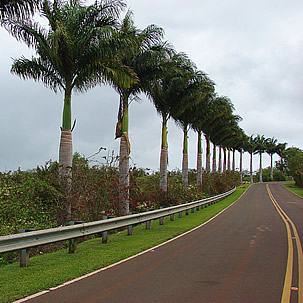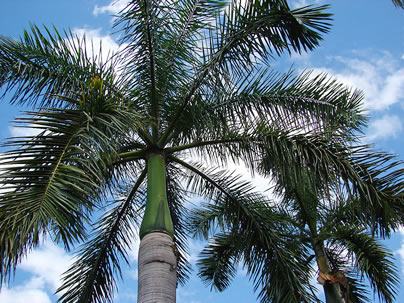The Cuban Royal Palm (Roystonea regia) is a majestic species, with a single trunk and large size, native to Florida, Mexico, Central America, and the Caribbean. It is widely used as an ornamental plant in tropical regions. Until recently, the Cuban royal palm and the Florida royal palm were considered distinct species, with the latter named Roystonea elata.
It reaches a height of 65 to 98 feet (20 to 30 meters) and a trunk diameter of about 20 inches (50 cm). Its trunk is erect, smooth, light gray in color, and can be cylindrical or curvilinear, usually with a thickened base. The crownshaft is covered by the leaf sheaths, which are green and very shiny. There are also varieties with reddish, variegated, or purple crownshafts, rare in cultivation. The leaves are pinnate, recurved, and reach about 13 feet (4 meters) in length, with linear and pendant leaflets, giving the overall appearance a feathery look.
The inflorescences emerge at the base of the palm heart, between the leaf sheaths, and bear flowers of both sexes, with a cream-white color. The fruits are ellipsoidal and turn purple when ripe. Bees, birds, and bats visit the flowers and fruits, feeding on them and thus contributing to pollination and seed dispersal.

In landscaping, the Cuban royal palm is ideal for large spaces, planted alone to complement the architecture of residences or tall buildings, in pairs framing entrances, in groups forming palm groves in gardens, parks, resorts, or in rows along avenues and waterfronts. Many consider it the most beautiful of all palms.
Despite its slow initial growth, after a few years of establishment and with proper irrigation and fertilization, the Cuban royal palm grows rapidly and vigorously. It is considered a “self-cleaning” palm, shedding old and dry leaves without the need for pruning. In areas prone to strong winds, such as tornadoes and hurricanes, the Cuban royal palm sheds its leaves as a protective measure against falls, regrowing soon after.
It should be cultivated in full sun, with at least 8 hours of daily sunlight, in fertile, slightly acidic soil enriched with organic matter and regularly irrigated. This palm thrives in slightly waterlogged soils as well as well-drained ones. It can tolerate short periods of drought, although it appreciates a significant water and fertilizer input to maintain its beauty and rapid growth.
The Cuban royal palm prefers a tropical climate, but it can be grown in subtropical or tropical high-altitude areas. In these locations, it is sensitive to frost and grows at a moderate pace. Propagation is through seeds, which should be depulped and germinated in sandy substrate kept moist. Germination takes about two months.


